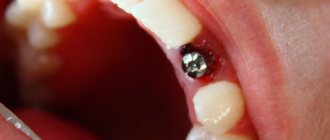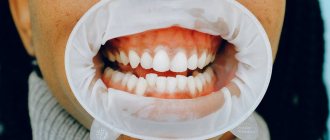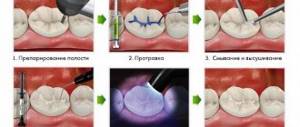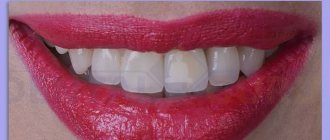Almost every person experiences fear of manipulation in dental offices. Therefore, a trip to the dentist is always postponed until the moment when an unhealthy tooth no longer causes mere discomfort, but severe pain.
But modern medicine does not stand still. The emergence of various methods of pain relief makes tooth extraction or treatment as comfortable as possible for the patient. What kind of anesthesia is used in dentistry, the advantages of using one or another type of anesthesia and what contraindications there may be - this will be discussed further.
What is anesthesia and indications for its use
Anesthesia should be understood as a decrease in sensitivity completely or partially. In dentistry, the medicinal version of pain relief is predominantly used, that is, the administration of certain drugs that block the flow of nerve impulses to the brain.
Thus, the patient does not feel pain during sanitation or extraction of teeth, and the doctor can perform manipulations efficiently and quickly.
Indications for pain relief are:
- Removal of a tooth
- Treatment of deep and medium caries
- Prosthetics
- Depulpation
- Surgical interventions
Anesthesia is divided into local and general.
Pain after removal
Since molar removal is still a surgical operation, albeit on a small scale, complications sometimes arise after it, including bleeding, inflammation of the gums, and loss of sensitivity. If the extraction went without complications, slight pain may be observed for 2-3 days after the intervention. There is nothing wrong with this; cool compresses help relieve swelling of the tissues; they are applied for 10–15 minutes.
To make the healing process of the hole more comfortable, the patient should follow the following recommendations:
- do not eat food immediately after extraction for 2–3 hours;
- make cool compresses 3-4 times a day, applying them to the painful and swollen area;
- do not visit places where the air temperature is too high or low and, moreover, do not allow sudden temperature changes;
- do not rinse the mouth on the first day so that a blood clot forms at the bottom of the hole - it is necessary to protect the wound from infection;
- in the absence of swelling and fever, you can relieve pain by taking Analgin, Baralgin or Ketorol tablets;
- give preference to soft food in the first two days after extraction;
- Do not drink carbonated drinks, spicy and sour foods.
If acute pain is accompanied by a rise in temperature and a sharp deterioration in well-being, you should not delay a second visit to the doctor - most likely, an infection has entered the hole or a small fragment of a tooth root remains there. Only a dentist can determine the cause of the ailment and solve the problem. The intensity of pain during extraction is the result not only of the anesthetic used, but also of the psychological state of the patient himself.
A problem-free procedure also depends on which teeth are being removed, whether there is an inflammatory process in the oral cavity, and whether the roots are large and thick. But in most cases, patients who were initially terrified of having their molars pulled out say goodbye to this problem forever, since modern dentistry allows extraction to be carried out absolutely painlessly and comfortably for the person.
Category: Tooth extraction Published by Mister stomatolog
Local anesthesia, its subtypes
In dental practice, in most cases, local anesthesia is used. It does not pose a risk to human health, but at the same time completely eliminates unpleasant sensations. In order to relieve sensitivity at the site of medical intervention, an anesthetic is injected into the person.
Compared to general anesthesia, local anesthesia lasts for a fairly short time.
However, it is sufficient to carry out the necessary dental procedures. Depending on the method of administration, the following subtypes of local anesthesia are distinguished:
- Applique
- Infiltration
- Conductive
- Intraligamentous
- Stem
Topical anesthesia is a type of local anesthesia, which involves the superficial application of an anesthetic to the area of the mucous membrane where pain needs to be numbed. For this, sprays or gels are most often used. This method of pain relief is suitable for opening minor abscesses, reducing sensitivity during injections, removing tartar, grinding a tooth before prosthetics, and removing loose baby teeth in children.
An infiltration subtype of local anesthesia is used in the treatment of caries or nerve removal. The injection is made into the area of the root apex, and makes it possible to numb one tooth or a small area of soft tissue.
This method often relieves sensitivity in the upper teeth, since the small thickness of the upper bone does not prevent the anesthetic from reaching the nerve endings.
The conduction method of local anesthesia is used if the infiltration method cannot give the desired results. The use of this subtype allows you to desensitize several teeth for quite a long period of time.
Depending on where the medical intervention will be performed, the following types of conduction method are distinguished:
- When manipulating the lower jaw - mandibular and torus.
- To desensitize teeth in the upper jaw – tuberal and palatine.
The intraligamentous method is often used in pediatric dentistry; it allows for tooth pain relief by injecting the drug into the area between the alveolus and the tooth root. At the same time, the tongue, lips, and cheeks do not become numb, so the possibility of accidentally biting soft tissues is eliminated.
Trunk anesthesia is used only in a hospital setting for serious injuries to the jaws and consists of injecting a drug into the area of the base of the skull, making the jaw completely insensitive. Its effect is long lasting and powerful.
Painkillers used in modern dentistry:
- Ledocaine;
- Ultracaine;
- Articaine;
- Ubistezin;
- Mepivacaine;
- Septonest;
- Trimecaine;
- Dicaine.
What does the sensation of pain depend on?
How painful it is to pull teeth, according to research, depends on several factors. In the same patient, the intensity of pain during extraction may vary depending on the following signs:
- a molar or baby tooth needs to be pulled out - removal of a baby molar is almost painless, since it does not have powerful long roots, like those of a permanent one;
- location on the jaw arch - frontal molars are removed with a feeling of much less intense pain, since they are smaller in size, their root system is not as developed as that of the lateral teeth. The same can be said about trauma to the surrounding soft tissues - they suffer less, especially in comparison with wisdom tooth extraction;
- tooth shape and number of roots - by nature, human molars can have 1-2 or 3-4 branches of a stabilizing root system. So, tooth extraction will be more uncomfortable the more root branches the molar has.
It is necessary to clarify that whether it is painful to pull out a tooth depends not only on the listed factors, but also on the perception of the procedure by the person himself. If you experience a feeling of panic and intense fear before the extraction, this psychological state can directly affect the procedure and actually provoke intense pain. There are many stories among patients not only about how much pain is felt during extraction, but also that there is a big difference whether a molar is removed from above or below, supposedly this affects the intensity of the discomfort.
We need to figure out whether these rumors have a scientific basis. Dentists claim that, regardless of the location of the tooth, it can be removed completely painlessly if high-quality anesthesia is administered, but the jaw may begin to hurt after the end of the freezing period. The severity of the pain syndrome will depend on several points:
- how much bone and soft tissue was destroyed;
- is there an acute inflammatory process at the time of removal;
- a frontal or lateral tooth is subjected to extraction;
- the lower or upper molar is removed;
- whether there is an accumulation of pus in the area of the unit being removed.
The fact that lower units are more difficult to remove from the bed is also due to the density of the bone tissue. All these factors directly affect the degree of destruction and recovery time after the molar has been removed. Therefore, it makes no sense to say that it is painful to remove the lower teeth, but not the upper ones; the location will only affect the adaptation period after extraction.
Contraindications for the use of local anesthesia
Before starting dental procedures, it is necessary to find out whether the patient has any allergic reactions or diseases that make it impossible to use local anesthetics.
Contraindications are:
- Allergy to painkillers.
- Having suffered a heart attack or stroke no more than six months before treatment.
- Diseases of the endocrine system, diabetes.
anesthesia methods should be used with caution.
regarding pregnant, nursing mothers and children.
Contraindications
Sometimes doctors cannot use anesthetics when extracting teeth. This is due to the contraindications of the drugs themselves and the individual characteristics of the patient’s body.
Among the most common contraindications:
- severe diseases of the cardiovascular system (stroke, myocardial infarction, after which less than six months have passed);
- allergy to compounds included in the painkiller.
If a patient has an endocrine disease that occurs in a decompensated form, he needs to go to the hospital for removal.
It is important to know . To avoid complications after using anesthesia, you need to inform the dental surgeon in advance about all existing chronic diseases, allergies, and medications used.
General anesthesia in dental practice
General anesthesia in dentistry is rarely used, mainly when it is necessary to carry out complex interventions in maxillofacial surgery, as well as in prosthetics. The drug is administered intravenously or by inhaling its vapor through a special mask. In order to treat teeth under general anesthesia, it is necessary to undergo a number of tests, such as an ECG, a general blood test, for hepatitis and HIV, and also consult an anesthesiologist.
Before manipulation, you should make sure that the patient is healthy to avoid possible complications.
Indications for this method of pain relief are:
- Intolerance to drugs used as local anesthesia.
- Panic fear of dental procedures.
- Mental pathologies.
Contraindications to this type of anesthesia:
- Diseases of the respiratory tract in the acute stage.
- Heart failure.
- Recent myocardial infarction.
- Drug or alcohol intoxication.
Indications and contraindications for tooth extraction
There are situations when the patient is very afraid of having a tooth pulled out and does not go to the dentist for a long time, preferring to endure the painful sensations on his own. And then, when he finally decides to visit the doctor’s office, he hears from the doctor that tooth extraction is not required, it can be cured and restored. Going for a consultation with another specialist, the same patient may hear that there is no way to save the molar and urgent extraction is needed.
Doctors’ opinions may vary, and consultation with different specialists is the full right of any person, but you also need to know about the indications for molar extraction:
- longitudinal fracture of the coronal part of the tooth with exposure of the nerve;
- the crown is so severely damaged that it is no longer possible to restore it;
- pathologies accompanied by destructive changes in bone tissue;
- periostitis in purulent form;
- a formed cyst or tumor in the periodontal area, especially against the background of a purulent-inflammatory process;
- incorrect position of the tooth in the row, which leads to permanent injury to the mucous tissue or the impossibility of high-quality installation of the prosthesis.
During orthodontic treatment, extractions are also often necessary to make room for teeth to move and restore proper bite. If a wisdom tooth constantly injures the mucous tissue, is characterized by incorrect growth and direction of eruption, and also if it cannot erupt completely, then it is an impacted molar - it also needs to be removed in time.
Contraindications to extraction:
- ARVI, acute tonsillitis, influenza;
- acute inflammatory processes of the gums and oral mucous tissues, such as stomatitis, gingivitis and periodontitis;
- general exhaustion of the body;
- the presence of malignant neoplasms;
- serious neurological diseases in the acute stage (epilepsy, psychosis);
- alcohol intoxication of the body.
The most serious contraindications for the removal of molars are acute pathologies of the cardiovascular system, such as angina pectoris, heart failure or a recent myocardial infarction. Particular attention is paid to patients with hemophilia; they are given a preliminary transfusion of hemophilic plasma before removal.
It is also impossible to take tooth extraction lightly in pregnant women at 8–9 months of age.











